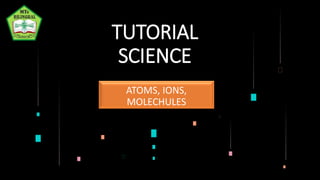
TUTORIAL ATOM, ION, MOLECHULE.pptx
- 2. Look at the diagram of part of the Periodic table of the elements. A. Use the Periodic table to write the electronic structure of aluminium (Al), oxygen (O), and calcium (Ca) B. How many of protons are in an atoms of fluorine (F)? C. A Sodium atom (Na), forms a sodium ions (Na+). Describe in terms of electrons, how a sodium ions is made from a sodium atom) 1
- 3. ANSWER A. We can count the atomic mass of the elements start from hydrogen. So the atomic mass of : B. Based on the periodic table, the protons of Flourine (F) is 9. Because the number of protons same with the number of atomic mass. Atomic mass can we get by counting orderly from H until F. Aluminium is 13. The electronic structure is 2)8)3). Oxygen is 8. The electronic structure is 2)6). Calcium is 20. The electronic structure is 2)8)8)2). C. It can be happened if sodium atom losses an electron or because of electrons lost.
- 6. Look at the diagram of a water molechule, H2O. A. State the type of bonding in a water molechule. ________________________________ Review the reason ________________________________ ________________________________ B. If the atomic NUMBER of oxygen is 8, review which group in periodic table oxygen belong by choosing the following true number. a. 8, because the group is based on the atomic mass. b. 2, because the atomic structure is 2)6) so the group is from the inner layer. c. 6, because the atomic structure is 2)6) so the group from the outer layer. d. 6, because group is from the atomic mass substract by 2.
- 7. DISCUSS WITH YOUR SEATMATE
- 8. The diagram shows the group of the Periodic Table that contains helium. The elements are in the same order as they appear in the Periodic Table. Elements Atomic structures Helium 1 A 2)8)18)8) Neon 2 B 2) Argon 3 C 2)18)8 Krypton 4 D 2)8) G 2)8)8) a. Connect the name of elements with the atomic structures. b. Review how the radius of the atom change as you go down the group.
- 9. DISCUSS WITH OTHER GROUP
- 10. The chart shows part of the reactivity series of metals. a. Magnesium reacts with oxygen to make magnesium oxide. Write the word equation for this reaction. b. If sodium and gold react with oxygen, conclude how the reaction by choosing the following statements. A. The result are sodium oxide and gold oxide. B. The reaction between sodium with oxygen will stronger than gold with oxygen. C. Sodium is most reactive, so it can not react with oxygen. D. The sodium is the most reactive so it can react with oxygen. But gold is unreactive so it can not react with oxygen.
- 12. The diagram shows part of the structure of an atom of helium. There are three types of particle in an atom. This diagram shows only two of the types of particle. a. Name the particles labelled Z. b. Name the particles that are missing from the diagram. c. Draw on the diagram the correct position and number of the missing particles.
- 14. The table shows the structure of different atoms and ions. What are the values of W, X, Z? Particle Proton number Nucleo n number Numbe r of protons Numbe r of neutro ns Numbe r of electro ns Mg 12 24 12 W 12 Mg2+ X 24 12 12 10 F 9 19 9 Y 9 F- 9 19 9 10 Z 1 W X Y Z A 10 10 9 9 B 10 12 10 9 C 12 10 9 10 D 12 12 10 10
- 15. The table gives the composition of three particles. Review the evidence in the table for each of the following? a. What is the electronic structure of particle A? b. What is the valency of the element? c. Is the element a metal or a non-metal? Give a reason for your choice. Particle Number of Protons Number of electrons Number of Neutrons A 15 15 16 B 15 18 16 C 15 15 17 2